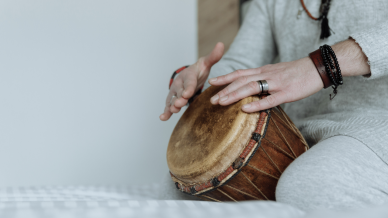West African drumming in the 21st Century is an ever-evolving art form based on ancient traditions. With dozens of ethnic groups spanning 19 countries, there is a rich and varied culture of music and dance across West African countries.
My interest is in the Mande music of Mali, Guinea, Ivory Coast and Senegal. In Mali and Guinea, Mande people identify themselves as Malinké and the majority of the music I have studied originates from these countries.
Drumming, dance and song play an important role in Malinké village life. Malinké are traditionally farmers who would celebrate community events through the Fete Malinké. This was an occasion of community gathering marking harvest time, a wedding, a naming ceremony of a newborn child or honouring or celebrating the various artisans such as blacksmiths (Numun) or leather workers (Garanke). Drummers would also accompany the farmers in the fields and provide working rhythms.
Whilst many instruments have been played for centuries the djembe is arguably the iconic drum of West Africa. This goblet-shaped drum made of a wooden shell, and a goat skin secured with rope and metal rings has spread worldwide. The word djembe comes from Anke djé, anke bé" which translates to "everyone gather together in peace" in the Bambara language.

A large cultural shift happened after 1958 when Guinea gained its independence from France and the first President Seckou Toure instructed Fodeba Keita, a musician and artist to create the first “Ballets” or performance groups who would take the traditional rhythms of the village and create performance choreographies which would then tour both the country and internationally to promote and celebrate the culture of Guinea.
Two Guineas masters who popularised djembe music outside of Africa were Mamady Keita (Wassalon region) and Famoudou Konate (Hamana region). Mamady Keita (1950-2021) created the Tam Tam Mandeng schools around the world and produced many of the first teaching materials through VHS videos, DVDs and print books from the late 1990s. Mamady’s work has been recognised as instrumental in popularising djembe music and interest in West African music.
Famoudou Konate, born in 1940, was one of the first principal djembe players (djembefola) of the Ballet Africains from 1959 to 1986. Since then, has continued to teach and promote Malinke culture around the world. He has reared the next generation of djembefolas based around the world through his five sons and family and thousands of musicians across the world have been studying this music and culture.
I travelled to Famoudou’s compound in 2007 and 2008 to study with Nansady Keita, Famoudou’s nephew who was also based in the UK for several years. In Conakry, we were taken to many Fete Malinké celebrations and I was fortunate enough to play at several events including weddings with Nansady and his musicians.
The traditional rhythms are played on djembe but absolutely fundamental are the dunun or bass drums. These cylindrical drums with cowskin heads are played with sticks and are in three sizes. Mamady Keita called the dununba (the deepest drum) the power or the father, the sangban (middle drum) the heart and the ken keni (highest drum) the spice.
Together these drums create the structure and the melody and are always traditionally played with the djembe. The rhythm pieces and the accompanying dances are named after the dunun melodies.
The rhythms are organised into families and some are played specifically for certain occasions.
For farming people the Kassa rhythms (kassa means granary) are particularly important, Numun rhythms are associated with the blacksmiths who are revered in Malinke society. Soli family rhythms are associated with male initiation, Mendiani rhythms are played for young female dancers. Wedding celebrations can take many days and there are rhythms for the bride and her family (Mendiani), the groom and his family (Toro and Soli) as well as the marriage itself (Djaa family).
There can be dozens of rhythms in each family. Dunungbe is known as the first of over 200 rhythms in the ‘Dance of the Strong Men’ family.
All of these rhythms are associated with songs and dancing and celebrations are often led by (often female) Griots or Djelis who will sing the praises of guests at the wedding and lead proceedings during ceremonies.
My study with Nansady Keita led me to learn around 50 rhythm pieces from many rhythm families. He taught me many songs and the cultural and folkloric background of the music he was teaching me.
Since meeting Nansady I have mainly studied with Iya Sako (Wassalon region of Guinea), Sidiki Dembele (Ivory Coast) and Hans Sutton. Hans is English but has been studying with six Malian teachers for over 20 years.
Through studying 30 Malian rhythm pieces over the last 10 years, I have further deepened my musical understanding and appreciation for West African rhythm in its many forms.
What I share with my students comes directly from the traditional teachers of Malinke culture. I aim to share my knowledge and love of the music and culture of the Malinke.
(c) Mark Barfoot 2024

If you would like to learn more about African drumming check out Mark's next course in Sunderland.




